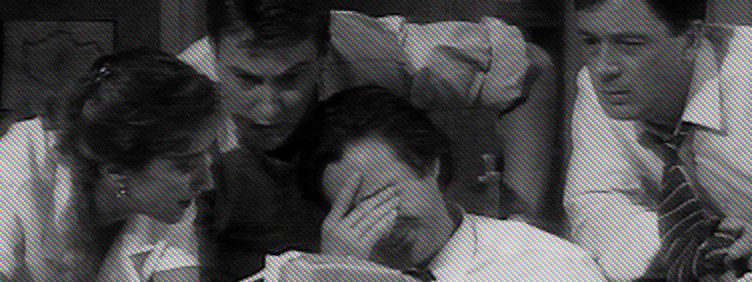
For as long as I can remember, I’ve been obsessed with TV pilots.
TV pilots of all kinds. Shows which eventually made it to the screen virtually untouched as part of a series, like The Young Ones episode Demolition. Shows which made it to screen, but which were substantially or entirely reshot for the series proper, such as Citizen Smith. One-offs which aired, but never became a series – remember Mirrorball? And then there’s my favourite: pilots which were never broadcast, either because they were never intended to be in the first place, or because substantial changes happened between the pilot and the series… or because they were a complete fucking disaster in every single respect.
There are so many of these unbroadcast pilots I’d love to see. There’s the 1986 pilot Dungeon Doom… followed by a second, also unbroadcast pilot under the more familiar name Knightmare in 1987. Similarly, 1983 saw an unnamed pre-pilot, followed by a full pilot called UNTV… with a series appearing the year after, a certain Spitting Image. Then there’s Paul O’Grady’s version of The Generation Game, which by rights should have been the BBC’s big entertainment hit of 2003… and wouldn’t you just love to watch the two pilots they made to see exactly why that didn’t happen?
Occasionally, such pilots get to see the light of day on DVD, if they ended up as successful shows. Sherlock saw its unbroadcast 60 minute version of A Study in Pink released. The Day Today is one of the most obvious comedy examples, with the bare bones of the show there… but the visual panache of the series very much not. And then there’s Doctor Who, where the DVD set The Beginning contains the complete unedited pilot recording, and a brand new edit combining the best of all the raw session’s takes. Because, y’know, Doctor Who.
With comedy, it’s easy to wish so much more was released.1 Blackadder is the most obvious example here, with a pilot which had never been officially put out on DVD, presumably due to somebody not wishing it to be out there.2 Slightly further afield, I would do anything3 to see A Big Bunch of Hippies, the pilot for the underrated sitcom Hippies – and even if you didn’t like the show, its unbroadcast pilot was the last TV show scripted jointly by Arthur Mathews and Graham Linehan, which is surely of interest to the discerning comedy fan.4
But occasionally, we get lucky. Hello Drop the Dead Donkey, Channel 4’s truly excellent 90s newsroom sitcom… which actually released its unbroadcast pilot on DVD in 2005. And watching it in the context of that first series from 1990 is rather instructive.
Let’s instruct ourselves, shall we?
* * *
“You’re about to watch something that really, quite frankly you shouldn’t be allowed to watch, because it was supposed to be a secret. It’s what’s called an off-air pilot, which is a dummy run. It’s where you get to practise making your programme before it spews out into people’s living rooms. Now, we did this a few weeks before we recorded the first series of Drop the Dead Donkey in 1990, and we did it because we knew as a new show with a topical element in it that there were loads of things that we really needed to practice.”
— Andy Hamilton, Pilot intro, Drop the Dead Donkey Series 1 DVD
“That was like a car crash.”
— Jeff Rawle, Pilot intro, Drop the Dead Donkey Series 1 DVD
The opening moments of the Drop the Dead Donkey pilot are, not to put too fine a point on it, a headfuck. Those familiar titles move down from the beam, the visuals exactly like Series 1… but we don’t have Matthew Scott’s urgent, pulsating theme tune. Instead we have a markedly inferior Philip Pope composition, which is a sentence I never expected to write and don’t expect to ever write again. But sure enough, we have found the single comedy show in the whole world which didn’t benefit from Philip Pope being involved. While the staccato teletype beats signifying news are present and correct, Pope’s composition feels more suited to some kind of parody chat show, rather than a newsroom sitcom. The vibe is altogether too relaxed.
The weirdest thing about this is that those visuals and Matthew Scott’s theme are so linked in my mind, I would have bet you anything that they had been jointly developed. The pilot proves that this wasn’t the case at all. This is the thing that pilots and deleted scenes do best: prove false your preconceived notions as to how something was made.
Once we’re into the episode proper, two things immediately strike you. Firstly, Gus is already in situ as Royston’s lackey, when he actually arrives in Episode 1 of the first series. Secondly, even Sally is already there and being her usual awful self, when she doesn’t arrive until the second episode of the show proper. This, then, is very much a test of how the programme was going to be, with the status quo of Episode 3 onwards: presumably a very deliberate act. You don’t want to practice the one-off circumstances of the first two episodes: you want to practice how you’re intending the show to be on a regular basis.
With that in mind, the pilot isn’t merely an early version of the first episode as broadcast. In fact, what’s most interesting is that it doesn’t actually resemble any episode of the series in terms of its main plot. Instead, we have the IT guys Gus has just fired infecting Globelink’s computers with a virus, which start spitting out confidential information to random people in the office. This strand doesn’t show up anywhere in the series proper; a few jokes are reused later on (which we’ll get to later), but nearly everything in this episode is unique to the pilot.
And I kinda love that. Andy Hamilton and Guy Jenkin weren’t scrabbling around, needing to use every single piece of material they had written. They were so prolific that they were willing to jettison a whole plot that they could easily have reused in the actual series, because they came up with something better. There are a great many writers who could learn from being less precious about their work.
Still, once you get past the music, and the surprise that the plot wasn’t reused, the pilot really is business as normal for the show. And what’s really fantastic is exactly how well drawn every character is from the off – and even more importantly, their relationships. So much of the series springs out fully-formed here. George and Alex are already arguing over ethics, Damien and Dave are already behaving like a couple of schoolkids, and Sally and Henry do not exactly get on like a house on fire. Indeed, it’s difficult to detect anything particularly different. Clearly most of the really hard work was done beforehand: by the time they reached the studios, they had the show.
And Liddy Oldroyd’s directing is already showing its teeth in the pilot. A friend recently called Drop the Dead Donkey “one of the best directed studio sitcoms ever”, and it’s hard to disagree. One of the most striking aspects of her direction is her willingness to go handheld at just the right moment. Drop the Dead Donkey wasn’t the first audience sitcom to use handheld cameras – Ed Bye’s work on Red Dwarf had done similar in the previous couple of years with Better Than Life and Marooned5, and I’m sure you must be able to find examples earlier than that – but for my money, Liddy’s work has the most impact. Just look at this section from the pilot:
In fact, the whole thing is about as far from a disaster as you can get. Not that you’d know it from the episode introduction on the DVD. I’ve already quoted Jeff Rawle’s opinion that it was a car crash, but here’s a few more choice words:
“We used to say, didn’t we, if we ever got a bit cocky – put that episode back on, watch it the night before you’re doing something else…”
— Robert Duncan
“You can’t release that.”
— Neil Pearson
“It was a pile of old dung, wasn’t it?”
— Robert Duncan, again
“Terrible. We were just so dreadful.”
— Jeff Rawle
“It was awful.”
— Robert Duncan, yet again
And in case that wasn’t enough, from the same introduction on the DVD, here is the EXACT moment when Neil Pearson and David Swift learn that the pilot is going to be included in the release:
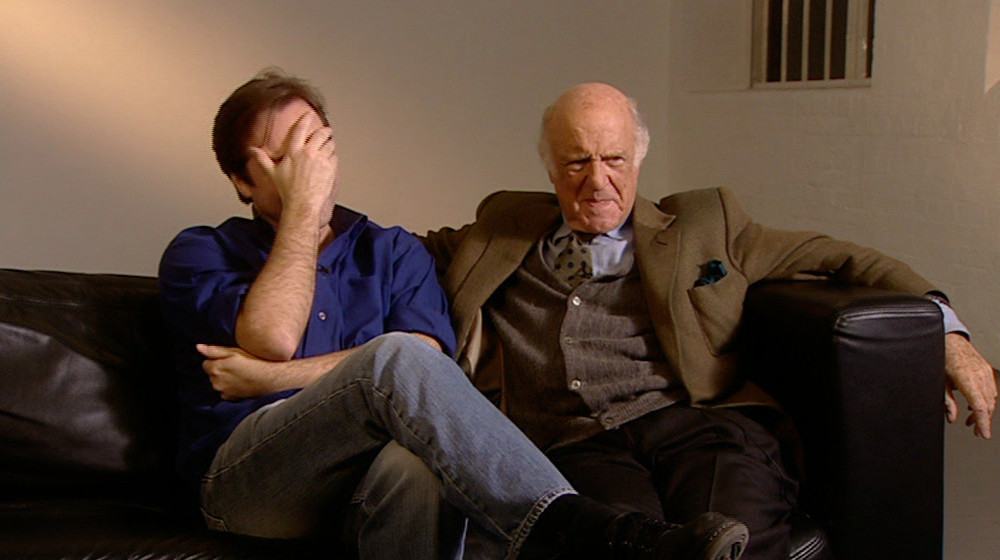
It’s frankly difficult to square their horror with what we see on-screen. Robert Duncan is a little sweaty at points, but that’s all, and I wouldn’t even have noticed if it hadn’t been gleefully pointed out by Stephen Tompkinson in the DVD introduction. I would suggest that the experience of recording a TV show often doesn’t bear much resemblance to the final product; something that people may have agonised over for an entire recording might be entirely transformed by the edit. It reminds me very strongly of how Rob Grant and Doug Naylor felt after the recording of the Red Dwarf episode Back to Reality – widely regarded to be the best episode of Red Dwarf ever made:
“There are weird moments, like with Back to Reality. Rob wasn’t involved in the edit for that, and I re-edited it quite extensively. And we were both very depressed going into the edit for that – because we thought at script level, we had a good show, and then when we shot it we didn’t think it was a good show at all… But I remember finishing the edit and calling Rob, and saying, “You should come in! I think it’s turned back into the show we thought it was!” And he didn’t believe me – but it had.”
— Doug Naylor, reddwarf.co.uk interview
That’s not to say that there aren’t a few oddities. It always seems a little counter-productive to criticise odd reactions from a studio audience: worries about exactly this kind of stuff by productions have resulted in exactly the kind of… shall we say “over-processed” audience laugh tracks we sometimes get today. (See my piece on the pilot of Hi-de-Hi! for some examples of this.) But even I have to acknowledge Henry gets some rather over-enthusiastic reactions to his lines. The worst among them is this:
Come on, it wasn’t that fucking funny. And while this is the worst example, it’s not the only one. Was David Swift’s family in the audience and causing trouble, or something?
But overall, the show is marvellous. If it has a fault, it’s that it isn’t quite as balls-to-the-wall hilarious as the series proper. For a pilot which is busy proving that the bones of the show work and was never intended for broadcast, that’s hardly a crime.
* * *
So, when was this pilot actually shot? In fact, it’s easier to work out than it might first appear.
The two date captions in the pilot are for ‘Wednesday July 25th 1990’ and ‘Thursday July 26th’. There’s no need to go rooting through the topical material in the main part of the episode itself to look for clues; we can leap straight to the ultra-topical jokes over the end credits. These are based around material current on July 26th: George Carey being named the new Archbishop of Canterbury, and Austrian President Kurt Waldheim meeting the Czech and West German presidents. We can assume then, that the recording of the pilot matched exactly the same pattern as the first series: the studio recording on the Wednesday night, with additional material over the end credits recorded on the day of “transmission”.
With the first actual episode broadcast on the 9th August, that means the pilot was recorded just two weeks before, giving a week’s break in the middle. (Andy Hamilton says “a few weeks” in his pilot introduction, but this is clearly isn’t quite correct.) This also gives just two weeks to dump the opening theme which wasn’t quite working, commission, write and record a new theme, and slot it into place for the first episode, which doesn’t seem like an awful lot of time, but I guess this is just “television made in a rush shocker”.6
Peculiarly, despite being shot in 1990, the copyright date at the end of the pilot is 1989. It looks suspiciously like the endboard was just pasted on from a Series 2 Whose Line is it Anyway? episode, but oddly enough they are slightly different:
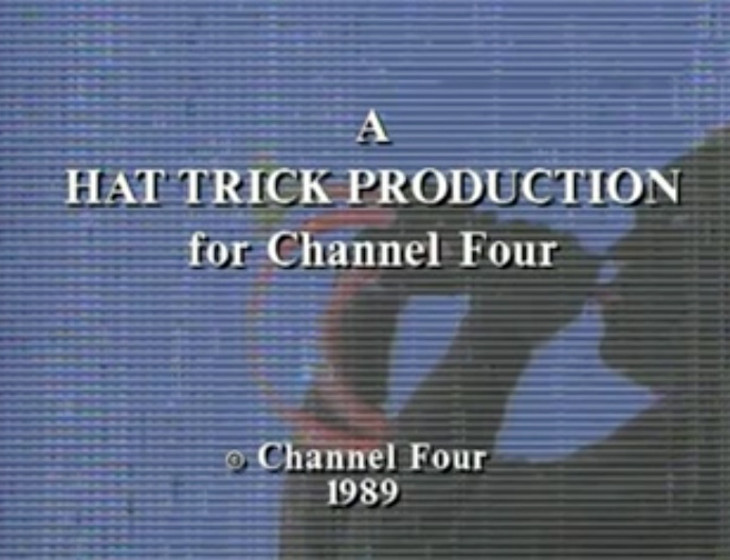
Whose Line is it Anyway? Series 2
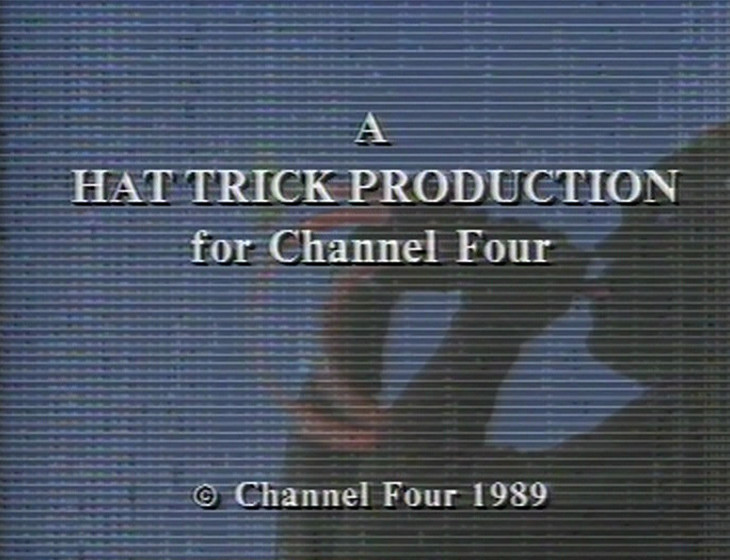
Drop the Dead Donkey pilot
My gut feeling here is that as the pilot was never intended for broadcast, they just grabbed any old caption they had hanging around. A bit odd, though.
* * *
I said earlier that while the main plot of the pilot wasn’t reused later in the series, a few of the jokes were. It wouldn’t be a Dirty Feed article if we just left it at that, would it? Let’s take a closer look at exactly what material from the pilot actually made it into the series as broadcast.
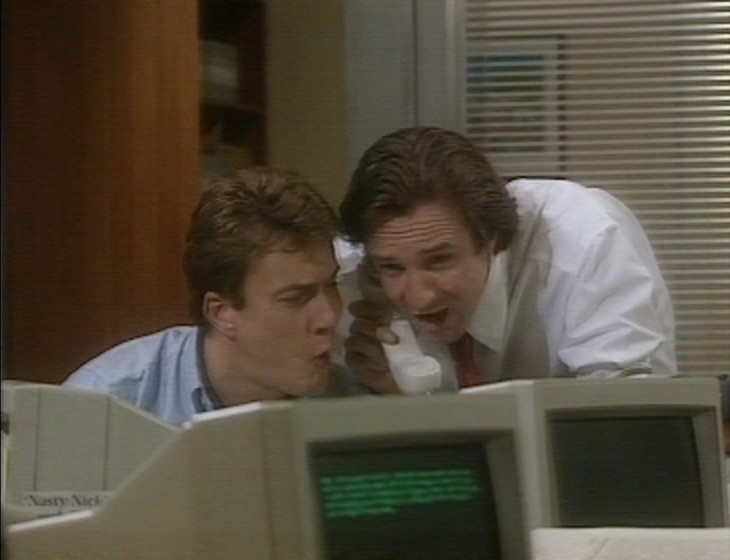
Pilot
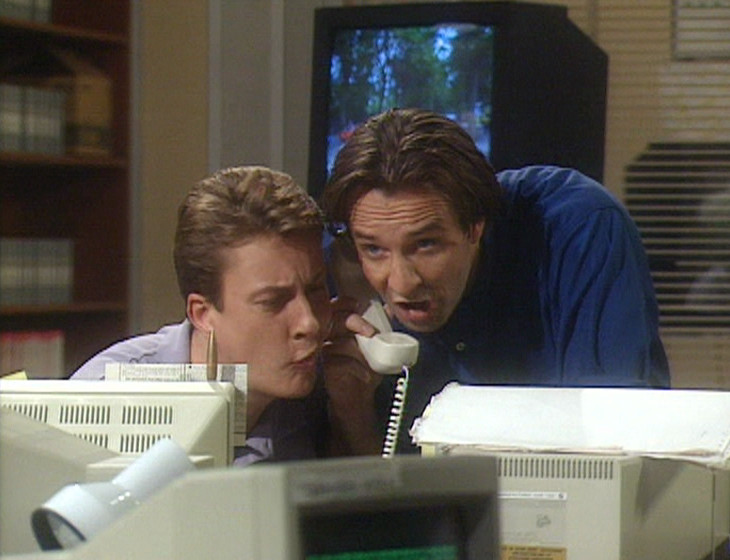
A New Dawn
First off, we have the joke about Nicholas Ridley from the pilot, about his dickhead remarks on the European Community and Hitler:
GEORGE: Now, nobody’s had an interview with Ridley since he went. Any joy on that front?
DAVE: Well, I’ll him try again George, but I just keep getting his answerphone.
HENRY: It’s a sad day, isn’t it, when insulting Germans is considered a resigning offence.
DAVE: Yeah, yeah, it’s the answerphone again.Damien imitates soldiers marching down the phone.
DAVE: Guten tag, Mr. Ridley!
Which is used almost verbatim in the first episode, A New Dawn:
GEORGE: Now, I know it was in the Express at the weekend, but nobody’s had a good TV interview with Ridley since he went. Any joy on that front?
DAVE: I’ll try him again George, I just keep getting his answerphone.
HENRY: It’s a sad day, isn’t it, when insulting Germans is considered a resigning offence.
DAVE: Yep, answerphone again.Damien imitates soldiers marching down the phone.
DAVE: Guten tag, Mr. Ridley!
The original story quoting Ridley was published in The Spectator on the 14th July, so it was still relatively topical by the time of the shooting of the pilot on the 25th July. An interview with Ridley was indeed published by the Sunday Express on the 5th August, so a bit of rewriting mentioning this was required for its inclusion in the first episode proper, broadcast on the 9th.

Pilot
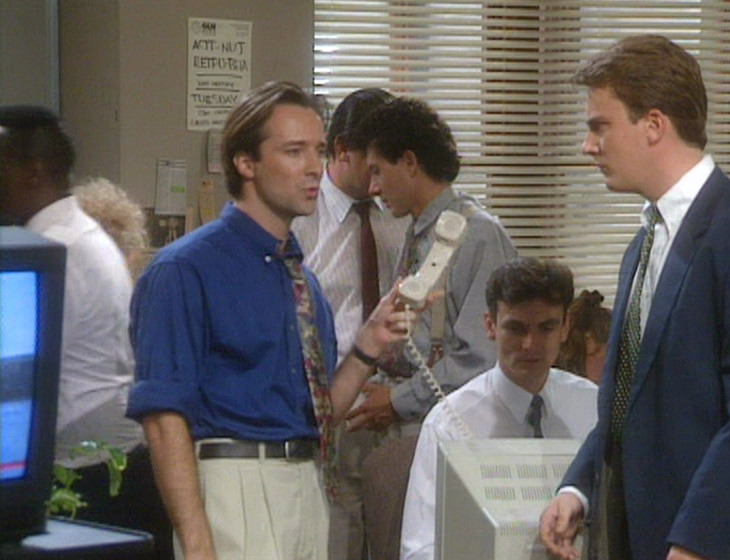
A New Dawn
Then there’s this stuff about corn circles7 from the pilot:
DAMIEN: I think I’ve got a piece on some new very large corn circles. You know, what causes them, is it some intelligent alien life force?
HENRY: They can’t be that intelligent if they just spend all their time drawing circles. Maybe they’re huge retarded Martians who enjoy playing noughts and crosses.[…]
DAVE: Damien, Damien. There’s a farmer on the phone for you. He says ‘How big do you want the corn circles?’
DAMIEN: Oh, great!
Which turned into the following in the first episode proper:
GEORGE: Now, are there any other stories?
DAMIEN: Yeah. I might have a story on some big new corn circles.
GEORGE: Good.[…]
GUS: George Dent is obviously the right man for this job. He runs a tight ship. He knows how to walk that tightrope between populism and irresponsibility.
GEORGE: Well, that’s right. I’m very strict on irresponsibility.
DAVE: Damien? Damien, there’s a farmer on the phone. He says how big do you want the corn circles?
DAMIEN: Oh, great!
The cutting of the “huge retarded Martians” section was a good call; it’s not especially amusing. Even better, the first episode ties the farmer punchline in with Gus needling George about Sir Royston; you’d never know the joke was ripped from the pilot. It’s lovingly moulded to fit like it was always there.
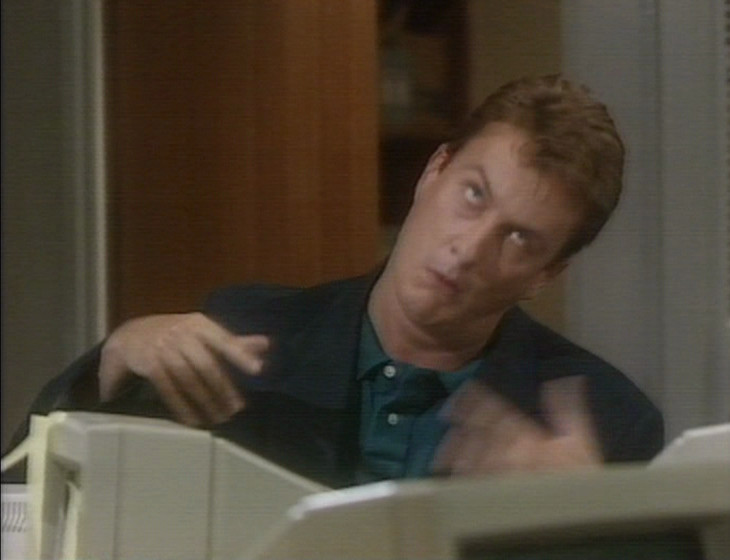
Pilot
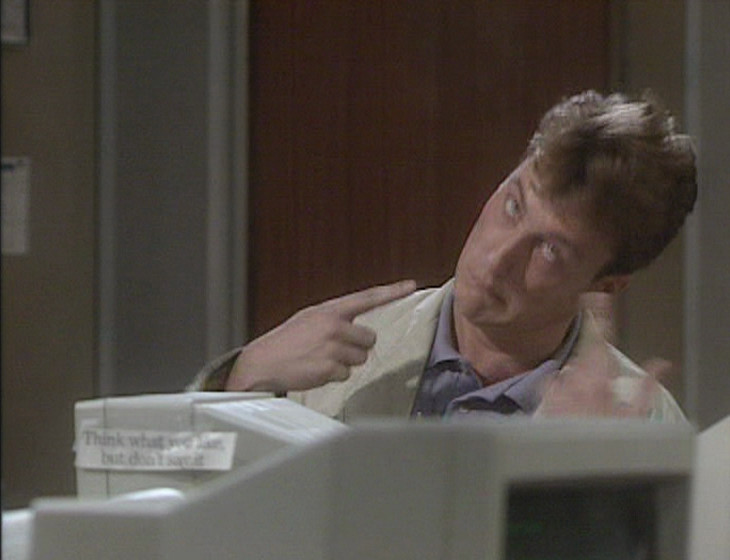
A Clash of Interests
Finally, there’s the following about BSE in the pilot:
GEORGE: Listen now, look, I want to have a quick postmortem on yesterday’s bulletin. Damien – your item on mad cow disease…
DAMIEN: Yeah, look, it was not my fault that the pictures were so dull, George. I mean, every cow in that herd had BSE. But could we get one of them to to stagger about in a wobbly kind of way? They just lay there idle doing bugger all and looking totally sane. Even after we lobbed in the firecrackers.
GEORGE: What do you mean, firecrackers?
DAMIEN: Well, you know, to get them all… [Damien pulls a mad face]
GEORGE: No, no, no, I don’t want to know.
Which eventually turns up in Episode 3, A Clash of Interests; again, virtually verbatim:
GEORGE: Right. Now, I just want to do a very brief postmortem on yesterday’s bulletin. Damien, your item on mad cow disease.
DAMIEN: Yeah, look, it was not my fault that the pictures were so dull, George. I mean, every cow in that herd had BSE. But could we get any of them to stagger around in a wobbly kind of way? No. They just lay there, doing bugger all and looking totally sane. Even after we lobbed in the firecrackers.
GEORGE: What do you mean, firecrackers?
DAMIEN: Well, you know, to get them up and… [Damien pulls a mad face]
GEORGE: No, no, no, I don’t want to know.
Interestingly enough, the joke is expanded in the broadcast episode into a running gag. Nothing like any of the following material is in the pilot:
ALEX: OK, you two, at the end we’ll put BSE in. Damien’s got some better pictures. Cows stumbling around, foaming at the mouth, etc.
[…]
DAVE: Hey. You know that latest mad cow footage of Damien’s?
GEORGE: Yeah?
DAVE: The farmer’s on the phone. He’s says he’s just found out his cattle feed is full of fairy liquid.
And:
ALEX: Damien! What on earth have you got there?
DAMIEN: This is next door’s cat. I’m just looking after it for them.
DAVE: You want to be careful. Cats can get BSE, you know.
DAMIEN: I know.[…]
GEORGE: Now, I want to do a follow-up on BSE. But no pictures this time, thank you Damien. No foaming cows, no cats that have been dosed up with Benylin.
Again, this shows a thoughtfulness to how the material was lifted from the pilot; it wasn’t just parachuted in to fill a gap, but was revised and expanded into a proper thread.
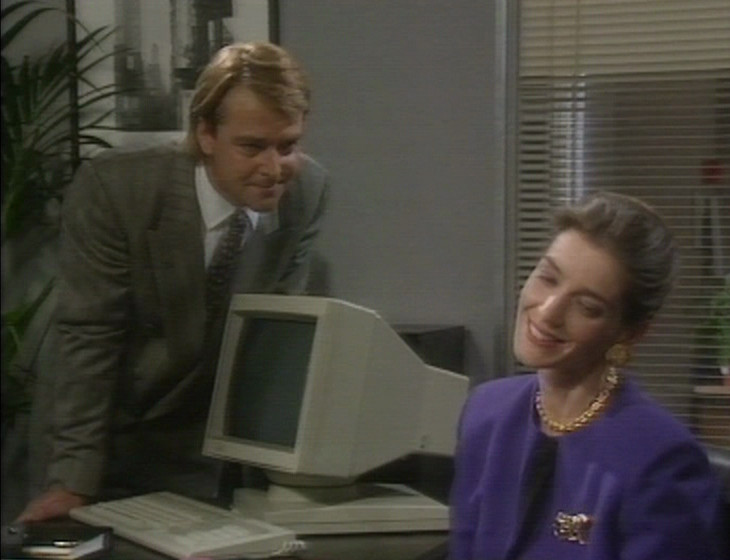
Pilot

A New Dawn
Finally, it’s not quite the same thing, but one joke structure was reused between the pilot and the first episode. The pilot:
SALLY: Of course, objectively I should get more money than Henry, but I suppose once again I’m to be penalised for my reasonableness.
GUS: Sally, I’ve always said it: when it comes to reasonableness, you’re in a class of your own.
And the first episode:
GUS: What if I disciplined him? I’d be severe.
GEORGE: Wouldn’t that undermine my credibility?
GUS: I think you’ll find your credibility will be the same as it always was, George.
It’s worth pointing out that adapting this gag for George in the final episode was a wise move; the relationship between Gus and George is more fundamental to the series than that between Gus and Sally. What Gus thinks about George is clearly a more important thing to get across in a first episode.
* * *
I started this article with the statement “For as long as I can remember, I’ve been obsessed with TV pilots.” A perfectly reasonable question, then, is: why?
I love TV pilots for the same reason as I love deleted scenes – or, for that matter, early drafts of novels.8 They’re an insight into a creator’s first stab at something, and therefore a vital first-hand look at the creative process. For all that I talk about the creative success of the pilot above, it wouldn’t have mattered if it had actually been a failure: that would have actually made it even more interesting. This is why I always stare in bemusement at DVD reviews which criticise deleted scenes for being crap: the quality of them is entirely beside the point. It’s how much of an insight they give into the making of something which is the real issue.
With Drop the Dead Donkey… well, see above. We learn so much about how the show was made from this unbroadcast pilot. Sure, the theme music is probably the most striking difference, and it’s fascinating to see how close we came to never having that classic theme tune. But the most interesting thing for me is how Hamilton and Jenkin pick out three specific jokes from the pilot to use in later episodes, even though they never ended up reusing the plot. There’s no revisionism here, years down the line, about which parts the writers actually really liked from the show: there’s primary evidence of exactly which bits they thought were funny. You don’t reuse material you’re not proud of – you run as far away from it as possible. And we only know about this because the pilot was released on on DVD, and we get to see it for ourselves.
A bit of a shame then, that the DVD market is dying.
Oh, it’s not entirely dead. The release of Kenny Everett’s Thames shows is proof of that. But as more and more people have turned to buying stuff on iTunes, or streaming on Netflix, any kind of bonus content – especially on TV show releases – has become increasingly thin. Hell, it’s as understandable as it is infuriating – as DVD sales slow, the budget for these releases will inevitably become smaller and smaller.
With Drop the Dead Donkey, we were lucky. The release of Series 1 in 2005 came at perhaps the height of the success of DVD, when the sales could justify the sourcing of extras.9 Sure, when the series was re-released as one huge boxset in 2015, the pilot was included – but that’s because it had already been sourced and cleared for release in 2005. If the series had been released for the first time in 2015, I would suggest it would be highly unlikely the pilot would have been included.
Don’t get me wrong – I don’t want the DVD or the Blu-ray market to die. I still buy both, and there’s an immense amount of comfort to be had in owning a physical disc which isn’t about to leap off the shelf into the ether. But if we want to go on enjoying the kinds of insight into television that unbroadcast pilots offer – and if we’d rather see them honestly, rather than having to rely on bootlegs – then there need to be more avenues for viewing this stuff.
We need iTunes to start including more of this stuff in its season purchases. We need Netflix to start streaming them, or iPlayer including them in their heavily-promoted box sets. The idea of bonus features isn’t wedded to DVD. To be fair, there have been some moves made in this area – I note there are behind-the-scenes documentaries on the iTunes release of The Detectorists, and deleted scenes for The Fall are on the BBC’s website – but, I would argue, nowhere near enough.
Or we could turn to television itself. For years, I really wanted BBC Four to do a “Pilots Night”, but it’d have to be fairly carefully handled. As much as I’d love them to stick the Knightmare pilot on the telly one night for no reason, these things work best with some context. Perhaps they could do a night of pilots for currently-running BBC shows: Doctor Who (hey, already released, but let’s draw people in with something popular), John Lloyd’s Newsround (the pilot of Have I Got News for You), Not Going Out, and Pointless. A bit out-there, maybe, but then isn’t BBC Four for trying out weird ideas every now and again?
Ah well. In the meantime, if you haven’t already seen it, I highly recommend you watch the full pilot of Drop the Dead Donkey. For what it’s worth, it’s on YouTube… but I’m not going to link to it. Instead, I urge you to buy the boxset of all six series, if you can afford it. If someone bothers to put out these little slices of joy commercially, rather than having to squint through a poor-quality YouTube bootleg, then let’s reward them for it.
Even if the Series 2 DVD – its original release, at least – did pull off the cruellest trick ever inflicted on a comedy fan.10
Admittedly, comedy in general has it better than game shows, or entertainment shows in general. Duncan Norvelle’s pilot edition of Blind Date is the stuff of legend,
and we’ve never seen so much as a field of it. UPDATE: Thanks to Ben Baker, who points out that parts of this pilot were seen in the documentary Who Killed Saturday Night TV? Now I’ve just got to pluck up the courage to watch it. ↩To be honest, it shuffles round the net so often like the proverbial video ghost that you’d think whoever it is might as well just throw up their hands, give in, and accept a few pennies out of it. ↩
Not actually anything. ↩
Yes, you there. Hello. ↩
In fact, there’s some handheld work in the very first episode of Red Dwarf, if you count pre-recorded material shot on the studio gantry, rather than stuff done in front of the audience. ↩
To be fair, it’s also possible that they had realised the original theme wasn’t quite what they needed, and commissioned the new theme earlier than this, and it just wasn’t ready to be put on the pilot. Either way, it’s fair to say that the theme was finalised at the last minute. ↩
Have we all decided it’s ‘crop circles’ now, incidentally? I don’t even remember them being called ‘corn circles’… ↩
I urge you to investigate the publication history of Great Expectations. ↩
Although even then, perhaps just barely. Series 1, 2 and 3 of Drop the Dead Donkey had extras… but Series 4, 5 and 6 did not. We can only presume that the sales of the first set of releases didn’t justify creating anything for the second set. ↩
Oh, you want to know what this was? Right, buckle up.
When you select the final episode of Series 2 – Xmas Party – on the DVD, up pops an introduction from Andy Hamilton and Guy Jenkin. “What you’re about to see is the full recording of an evening of Drop the Dead Donkey – that’s to say all the scenes being recorded, in order, in front of a live audience at London Studios. So you’ll be seeing it warts and all.”
Amazing. So, you strap yourself in, get an extremely large glass of wine, settle back, and are greeted with… the broadcast episode of Xmas Party, rather than the full studio session. OH BOLLOCKS.
There are two questions here. Firstly: why did the studio session not end up on the DVD? Space reasons, and the budget couldn’t stretch to a third disc? Or did one or more cast members complain? (They already seemed fairly concerned about the pilot being included.) Secondly – why the hell was this intro used on the final version of the DVD? Surely they should have realised that bolting on this intro to the broadcast version of the episode was a ridiculous idea?
Yes, I’m still angry about this, what’s your point? ↩

3 comments
Iain on 1 November 2018 @ 3pm
An excellent bit of TV archaeology. Also nice to see some proper love for what remains, bizarrely given how popular it was, one of the great undersung comedies of the 90s (and one of the most accurate newsroom depictions I’ve ever seen)
One question (one I suspect you won’t be able to answer but I’ll try anyway) that’s always bugged me just how untransmitted the pilot was.
I know the full thing wasn’t available until the DVD release, and admittedly I was 12 when the first episode aired, but I could swear I’d seen the Ridley joke and the crop circles joke before the first episode. I’m not sure if it was a trailer or some preview clip on something, but I’ve a very strong (and probably erroneous) feeling that at least one clip of the pilot was shown before the actual first episode, and it was a standout joke at that.
John Hoare on 1 November 2018 @ 9pm
Hmmmmm.
It wouldn’t surprise me at all if clips from the pilot were used to represent the series in some kind of early publicity for the show. As the show was recorded the day before transmission, if they wanted to trail the series in any way, unless it was some kind of specially shot trail, they’d *have* to use clips from the pilot. And surely they trailed the series, didn’t they?
So if anybody reading this has any Channel 4 continuity from around August 1990, now is the time to look…
Richard Gadsden on 15 April 2021 @ 2pm
It seems that someone has finally responded to your desire for extras to be included on streaming – Disney Plus does have extras! Mostly for films rather than TV, but they do have them.
(they also have options for content; for instance you can watch early seasons of the Simpsons in remastered 16:9 or original broadcast 4:3).
Comments on this post are now closed.